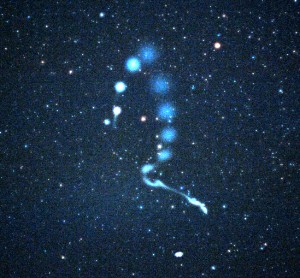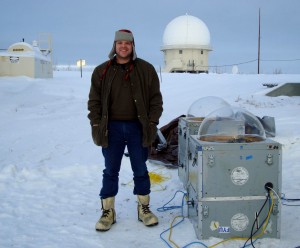Measuring the winds of space: UAF team prepares for 2014 launch
April 30, 2013

Molly Rettig
4/29/2013
On a clear, cold night two winters ago in Fort Yukon, Carl Andersen watched a rocket he helped design pierce the upper atmosphere. He and three other scientists shot pictures as the rocket ejected bright puffs of chemicals in an inverted V formation more than 60 miles up.
"They were the brightest things in the sky," Andersen said from his office at the University of Alaska Fairbanks.
Other scientists watched the puffs drift across the sky from Toolik Field Station in the Arctic and from Poker Flat Research Range, UAF’s sounding rocket range 30 miles north of Fairbanks. They would piece together thousands of images from the three locations to track the chemical tracers against the star field to calculate their position and measure atmospheric conditions.
"We're taking a very short but very accurate close-up picture of the winds," Andersen said.
They were testing out a new payload design, which is the package of scientific instruments attached to the rocket, aimed at getting a bigger and more three-dimensional view of winds. The design uses smaller rockets to eject sub-payloads of instruments off the main rocket. In the next few weeks, Anderson’s group will begin ground testing this improved design for the next launch, planned for winter 2014.
Andersen is a doctoral candidate in the space physics and aeronomy group at the UAF Geophysical Institute. He has worked with a team, under assistant professor Mark Conde, on the sounding rocket program for three years. Sounding rockets carry instruments that take measurements and perform scientific experiments.
Chemical release experiments have been conducted at Poker Flat for decades. Basically, you shoot a rocket to a certain altitude and it releases "luminous puffs" of chemicals into the atmosphere that are bright enough to see from Earth, Andersen explains. Scientists on the ground study the movement of the puffs at various altitudes, which will help them better understand and predict conditions in this relatively obscure layer of the atmosphere.
"Imagine a river. You drop a packet of dye in it. It would either move with the current or the turbulence would stir it up, and you could use that little tracer packet to take measurements of what's happening."
The area Andersen studies is the lower thermosphere, or the beginning of space. Situated 100-200 kilometers from Earth, it is filled with uncharged molecules like oxygen and nitrogen as well as hot ionozed gas called plasma. It's also the part of space where the aurora occurs.
Far less is known about this region of the atmosphere because it’s difficult to measure. While the troposphere, less than 10 kilometers away, is well-documented by radar, aircraft, weather balloons and weather stations, the thermosphere is too high for such instruments. It's also too dense for satellites, which are used to take measurements farther out in space (200 kilometers or more). Rockets are thus an effective and relatively cheap measuring tool.
Learning more about the thermosphere will improve researchers' ability to build models and make predictions about space weather. This can impact fields like communications and satellite operations.
It can also deepen our understanding of the aurora and space physics.

The 2010 launch tested two techniques for releasing chemical tracers. Typically in these experiments, a trail of harmless chemicals would be sprayed from a tank on the rocket.
But now researchers want to sample a 100-kilometer 3-D box for a more detailed look at the wind field, which means the puffs have to go farther and wider than previous designs.
"In order to get this 3-D constellation of points, there had to be secondary deployable sub-payloads on the main rockets. The rocket travels up, it ejects a whole series of little rockets that shoot off to the side. The little canisters explode and open and deploy their parcel of liquid," Andersen said.
They also tried spring-powered ejectables that would simply fling off the big rocket, but they didn’t go far enough.
Andersen says rockets are just one piece of the thermosphere research puzzle and can complement ground-based optics, spacecraft, radar and lidar (light radar), among other tools.
Since the late 1970s, the University of Alaska Fairbanks’ Geophysical Institute has provided this column free in cooperation with the UAF research community.


